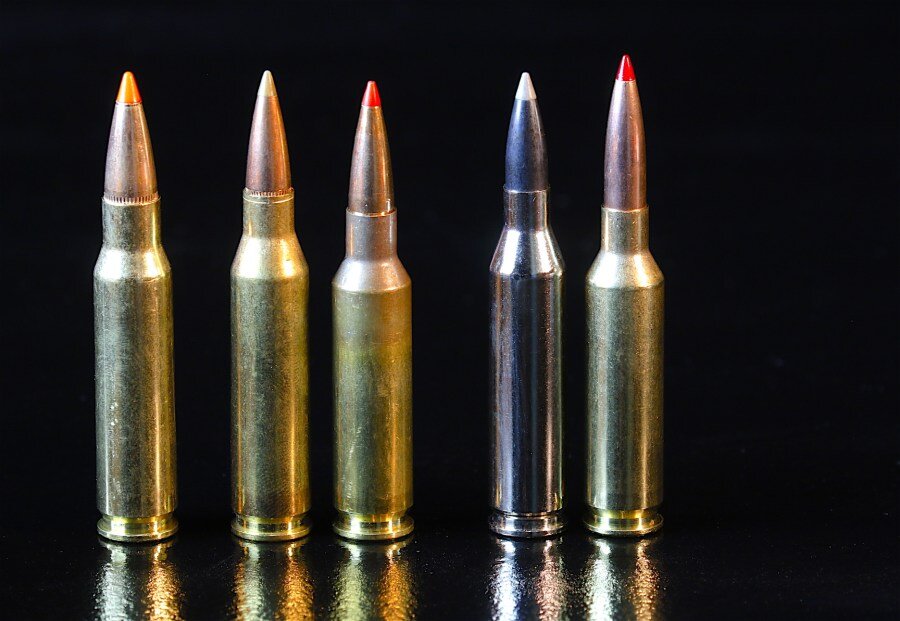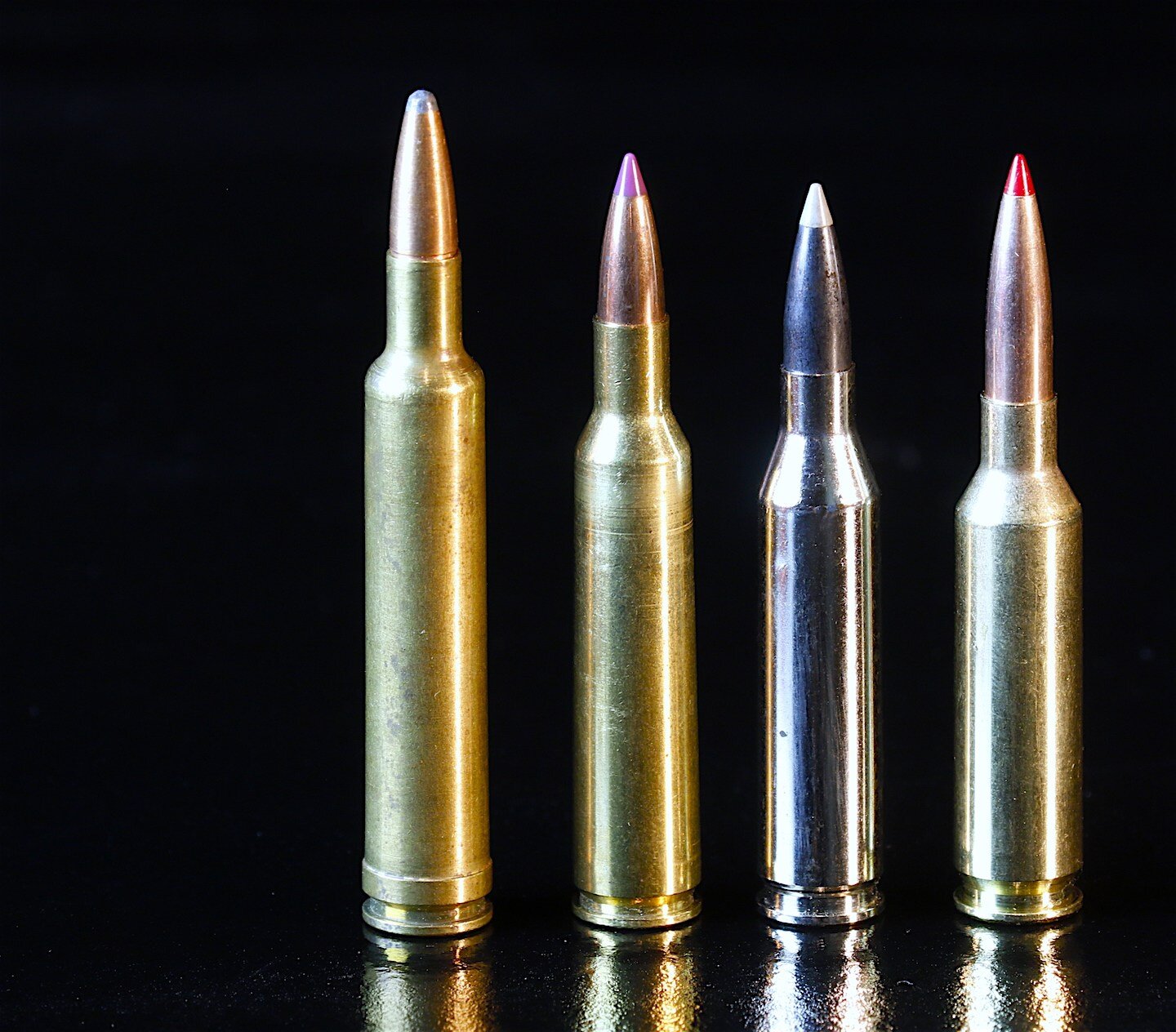Why I'm Not Buying 6mm Creedmoor
The popular new kid in the rifle world is the 6mm Creedmoor. It’s winning all kinds of target competitions. It’s also dropping pronghorns, whitetails, mule deer, coyotes, and even elk — and I’m not buying one.
Before I tell you why, let’s examine this magical new cartridge in detail and you can decide if you can afford to ignore it, too.
6mm Creedmoor Genesis
The Great Grandma 308 Win. on L. has inspired a host of small calibers. Note how the 6.5 Creedmoor (3rd from L.) compares to the 260 Rem. and the 6mm Creedmoor compares to the 243 Win. (4th from L.)
As its name suggests, the 6mm Creedmoor sprang from the 6.5 Creedmoor and the devious mind of my friend John Snow, gun columnist at Outdoor Life magazine. Back in 2009 John asked the engineers at Hornady if they’d neck their 6.5 Creedmoor down to make his 6mm version, and they did. The round began winning a high-speed shooting game known as Precision Rifle Series competition. Targets are engaged clear out to 1,300 yards, and the faster you hit them, the higher your score. Seeing hits and misses is important in this game, so a cartridge that will shoot fairly flat, resist wind deflection and minimize recoil is critical. The 6mm Creedmoor does that by handling extremely long, high B.C. bullet in AR-10 rifles.
Now let’s get back to the cartridge itself. As noted, the 6mm Creedmoor was hatched from the 6.5 Creedmoor, and that round is the ballistic twin and nearly identical physical twin to the 260 Remington. It’s essentially the 260 Rem. case with the shoulder pushed back a bit to lengthen the neck. The shoulder is sharpened from 200 to 300 as in the 30 TC cartridge. The result is internal volume about 5% less than the 260 Rem, but less bullet intrusion into that powder space. Both cases drive 140-grain bullets within 50 fps to 100 fps of each other.
6mm Creedmoor in Good Company
From L: 240 Wby. Mag., 6mm Rem., 243 Win. and 6mm Creedmoor. All are viable hunting cartridges, but the Creedmoor is proving the best competition round.
Similarly, the 6mm Creedmoor compares to the 243 Winchester. As most of us know, Winchester unleashed its 243 Win. in 1955, the same year Disneyland opened, gas cost 23 cents per gallon and we launched the world’s first nuclear submarine. The 243 Win. was and still is the 308 Winchester (detailed in this article) necked down to 24-caliber, just as the 260 Rem. is the 308 Win. case necked down to 26-caliber, albeit with a slightly longer body to prevent accidental chambering in 243 Win. rifles.
As you can figure out, all these similarities suggest the new 6mm Creedmoor should perform about like the 243 Winchester. It does. Both cartridges throw 100-grain to 108-grain bullets about 2,950-fps to 3,000 fps MV from 24” to 26” barrels. So will the old 6mm Remington (circa 1955.) If you want to go faster than that, grab the 240 Weatherby Magnum or 243 WSSM for another 100 fps. If you want to go slightly slower, there’s the 6x47mm Lapua and even the 6mm Bench Rest Remington.
Why the 6mm Creedmoor?
The 6mm Creedmoor was designed to shoot long, high B.C. bullets far and accurately.
Why all these 243-caliber (6mm) cartridges? Fine tuning. Truly. Any and all will suffice for taking game. It’s when you start tweaking performance in order to get a leg up on your competition that you justify these cartridges. And that’s why I’m probably not getting a 6mm Creedmoor. I'm not a competition shooter. I’ve already got a 243 Win. and a 6mm Rem. I use both for hunting and just a bit of fun target shooting. Both routinely group MOA, often half that with certain bullets and loads. Both match the ballistic performance of the 6mm Creedmoor. So the Creedmoor — balanced, accurate and mild shooting though it may be — offers me nothing I don’t already have.
This doesn’t mean it's not perfect for YOU. It might not be radically different from our older 6mms, but it's not the zombie shooter craze or today's hula hoop either (that’s a 1950s reference, kids.)
If you're in the market for a 6mm, you should seriously consider the 6mm Creedmoor. If you want to indulge in extreme range shooting and contests like PRS, especially with an AR-10 platform rifle, 6mm Creedmoor is probably perfect. If your need is for an accurate, flat shooting, mild-recoiling hunting rifle, a 243 Win. might be the smarter option because there are many, many more rifles and factory loads available for it. If you handload, either round will work just fine. As of this writing, only Ruger is producing factory rifles in 6mm Creedmoor, but that will surely change soon.
One More 6mm Creedmoor Consideration
Traditional bullets like Sierra 85-gr. HP, Nosler 80-gr. BT and Scirocco 90-gr. Boat Tail are designed to stabilize in 1:10 twist barrels. High B.C. bullets like Hornady's 108-gr. ELD Match and Berger's 115-gr. VLD Target need 1:8 or 1:7 twist.
Finally, here is one more consideration: rifling twist rate. This is critical if you appreciate long range potential and precision. As explained in this twist rate article, today’s most efficient, high B.C., long-range projectiles require faster twist rates than are traditional. Remington famously missed the boat with a too-slow twist rate (1:12) with its original 244 Remington cartridge in 1955. Forced to increase twist to compete with the 243 Winchester, Remington reintroduced the 244 Rem. with a 1:9 twist barrel and renamed it the 6mm Remington as it’s known today. Unfortunately, too little too late, and this round is nearly obsolete. The 6mm Creedmoor may be the final nail in its coffin.
Most 243 Win. and 240 Wby. Mag. rifles come with 1:10 twists, which are not quite quick enough to stabilize today’s longest, highest B.C. bullets. Hornady recommends 1:9 twist or faster for its 105-grain A-Max and BTHP Match. Hornady’s new 108 ELD-Match needs a twist of 1:8. Hornady rates this projectile with a G1 B.C. of .536. Compare that to traditional 100-grain .243 bullets that top out with B.C. of around .405 and you’ll understand why the faster twist is needed. Other high B.C. bullets a 6mm shooter might consider are:
Berger 115-grain VLD Hunting (B.C. .568, 1:7 twist)
Sierra 107-grain MatchKing (B.C. .547, 1:8 twist)
Sierra 110-grain MatchKing (B.C. .617, 1:7 twist)
Nosler 107-grain Custom Competition (B.C. .525, 1:8 twist)
David Tubb DTAC 115-grain Closed Nose (B.C. .590, .620, 1:7 twist)
The writing is on the target board, folks. Shooters and the industry have finally tumbled to the inherent benefits of ballistic efficiency. Long-range shooting and the need for aerodynamic efficiency are what’s driving innovation in new bullets and cartridges like the 6mm Creedmoor.
Conclusion
If you want a 6mm rifle of any kind primarily for hunting at reasonable ranges, a traditional 243 Win., 6mm Rem. or 240 Wby. Mag. will serve you perfectly. But, if you want to work with today’s most efficient bullets to minimize drop and drift while maximizing retained energy for downrange performance, you might want the new 6mm Creedmoor. It could well become the most popular 6mm cartridge of the future.
The 243 Win. was developed in an era when bullets weren't as long as some are today. As a result, most 243 Win. barrels 1:10 twist rate won't stabilize the high B.C. bullets the 6mm Creedmoor is designed for.
Ron Spomer doesn't remember the year the 243 Winchester was introduced, but he was toddling around then. He doesn't recall the introduction of the 6mm Creedmoor, either, because he was too busy shooting his 243 Winchester.

























